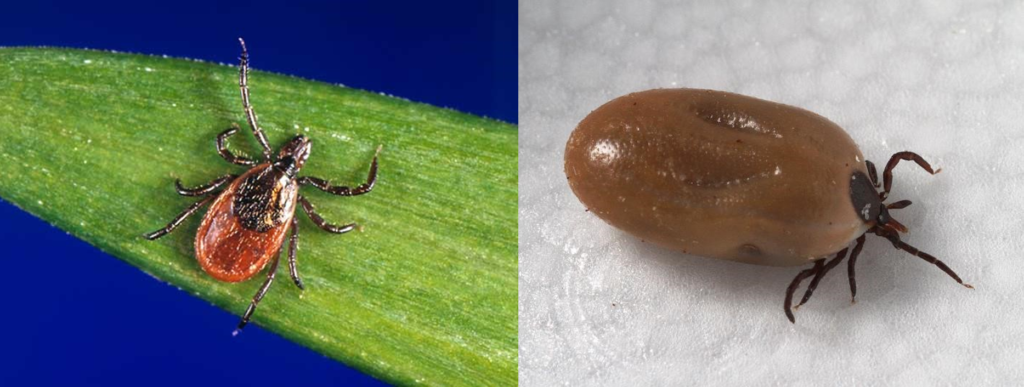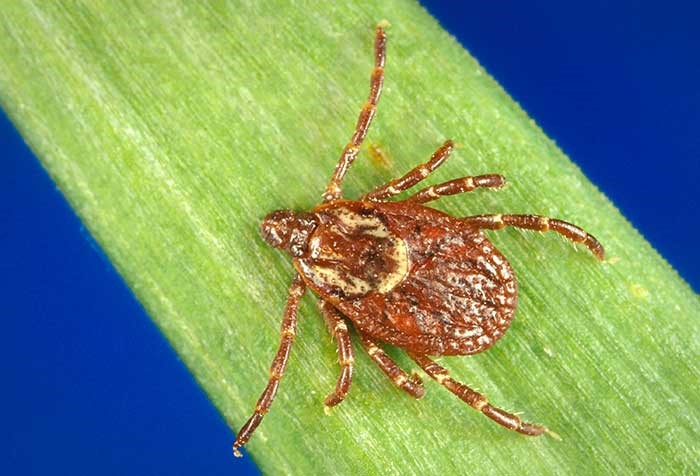Featured Author: Alexandra Wickson, MPH
What are ticks?
Ticks are parasitic insects that feed on the blood of people and other animals. They have four life stages: egg, larva, nymph, and adult. All life requires food to live, and for tick larva, nymphs, and adults, this food is blood (researchers call this a ‘blood meal’). Ticks of different species or life stages may prefer different animal hosts to feed on.

This tick is commonly known for carrying Lyme disease, and people are most often infected by ticks in the nymph life stage. This tick can also carry anaplasmosis, babesiosis, Powassan disease, and others. Photos from CDC/Dr. Gary Alpert.
Some of the most common tick species in the U.S. are:
- Blacklegged or Western Blacklegged tick (commonly called the “deer tick”)
- Lone Star tick
- American Dog tick
- Brown Dog tick
- Gulf Coast tick
- Rocky Mountain Wood tick
Identifying ticks can be tricky. Depending on the life stage and sex (if it’s an adult), the tick may look different. When adult female ticks feed, they grow to many times their size because they require a large blood meal in order to lay eggs.

An example of the small size of Blacklegged tick nymphs (“Deer ticks”) as seen on a poppy seed muffin. The nymphal ticks are about the size and color of a poppy seed. Photo from CDC.
Diseases Ticks Carry
Ticks can carry a variety of diseases that can make people and their pets sick. Diseases that ticks carry depend on the tick species and life stage. Ticks in the U.S. can carry the bacteria that causes Lyme disease, Rocky Mountain spotted fever, babesiosis, tularemia, anaplasmosis, ehrlichiosis, and other diseases. Some tick species can carry viruses too, such as Powassan virus or Heartland virus. Several of these diseases can be deadly to you or your pets.

An adult female American dog tick. This tick is known for carrying Rocky Mountain spotted fever and tularemia). Photo from CDC.
How to Prevent Tick Bites
Ticks find their hosts by waiting on the top of grasses and plants. They latch on when a host brushes past and then look for a suitable spot on the host to bite. Ticks are found most everywhere, including your own backyard, so always be sure to check for ticks after spending time outside.
To avoid ticks and prevent tick bites:
- Use insect repellent, such as DEET, that you can find at most grocery and drug stores. Different types of repellent are effective for various amounts of time.
- Check yourself and your pets for ticks as soon as you come inside.
- Taking a shower right after coming inside helps rinse off ticks that aren’t attached yet and is a good way to check for ticks that are attached to you.
- Put your clothes into the dryer (without washing them first) on high heat for about 10 minutes to kill any ticks on them.
- Treat your pets for ticks or purchase a collar that protects against ticks. Protecting your pet protects you because pets can carry ticks into the home, exposing you to ticks while playing or sleeping with your pet.
- Treat your clothing with 0.5% permethrin. You can treat your gear yourself or buy pre-treated clothing and gear. Permethrin is available at most outdoor suppliers. It works via contact and is very effective for things that remain on your clothing (thus great for ticks, not good for mosquitoes). Follow the directions to effectively treat your clothing.
Treating Tick Bites
If you are bitten by a tick, it’s important to remove the tick as soon as possible. Some diseases can be spread soon after the tick attaches to you, but others like Lyme disease, typically require the tick to remain attached for 36-48 hours, so finding and removing ticks quickly helps to prevent infection.
To remove a tick:
- Wash your hands and find some fine-tipped tweezers.
- Use the tweezers to grab the tick as close to your skin as possible. You want to grab the tick’s mouthparts and avoid squeezing the body of the tick. (Squeezing the body can increase the risk of infection).
- Slowly pull straight up and out. Do not twist or yank .
- After removing the tick, check for any remaining parts, remove as you would a splinter, and then clean the area around the bite.
- To dispose: wrap the tick in tape or put it into a closed bag with alcohol and throw it away. You can also put it into a sealed bag and freeze it if you wish to keep it in case you become infected, though testing ticks for disease is not usually recommended. If you decide to freeze the tick, be sure to double bag it to be safe.

If you develop a rash, fever, or other symptoms after being bitten by a tick, visit your doctor and let them know about the tick bite. Keep in mind that rashes from tick bites look different on different skin tones. If your pet shows signs of illness after being bitten by a tick, take them to the veterinarian.
Further Reading
For more information on ticks, visit: https://www.cdc.gov/ticks/index.html
